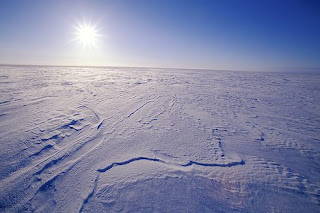
(Source: http://digitalmedia.fws.gov/)
During Winter, the average temperature is about -30 degrees fahrenheit. The freezing cold temperature causes the ground to form in layers of frozen soil known as "permafrost." This makes it difficult for plants to grow because their roots can't penetrate the frozen soil. During the short summers, however, the average temperature increases, causing the upper layer of soil to melt and allowing plants to cultivate. A second effect of the increased temperature during the summer is the formation of small bodies of water. Since the lower layers of soil remain frozen, the water has nowhere to go so it just stays there, forming marshes and sometimes lakes. Despite these conditions, the Arctic Tundra is home to over 1700 types of plants. As for animals, while there are only 48 ground mammals that live here (including polar bears, arctic foxes, squirrels, caribou, and more), there is a high population of each species; and every year there are large masses of birds that migrate here to feed on the abundance of insects.

No comments:
Post a Comment